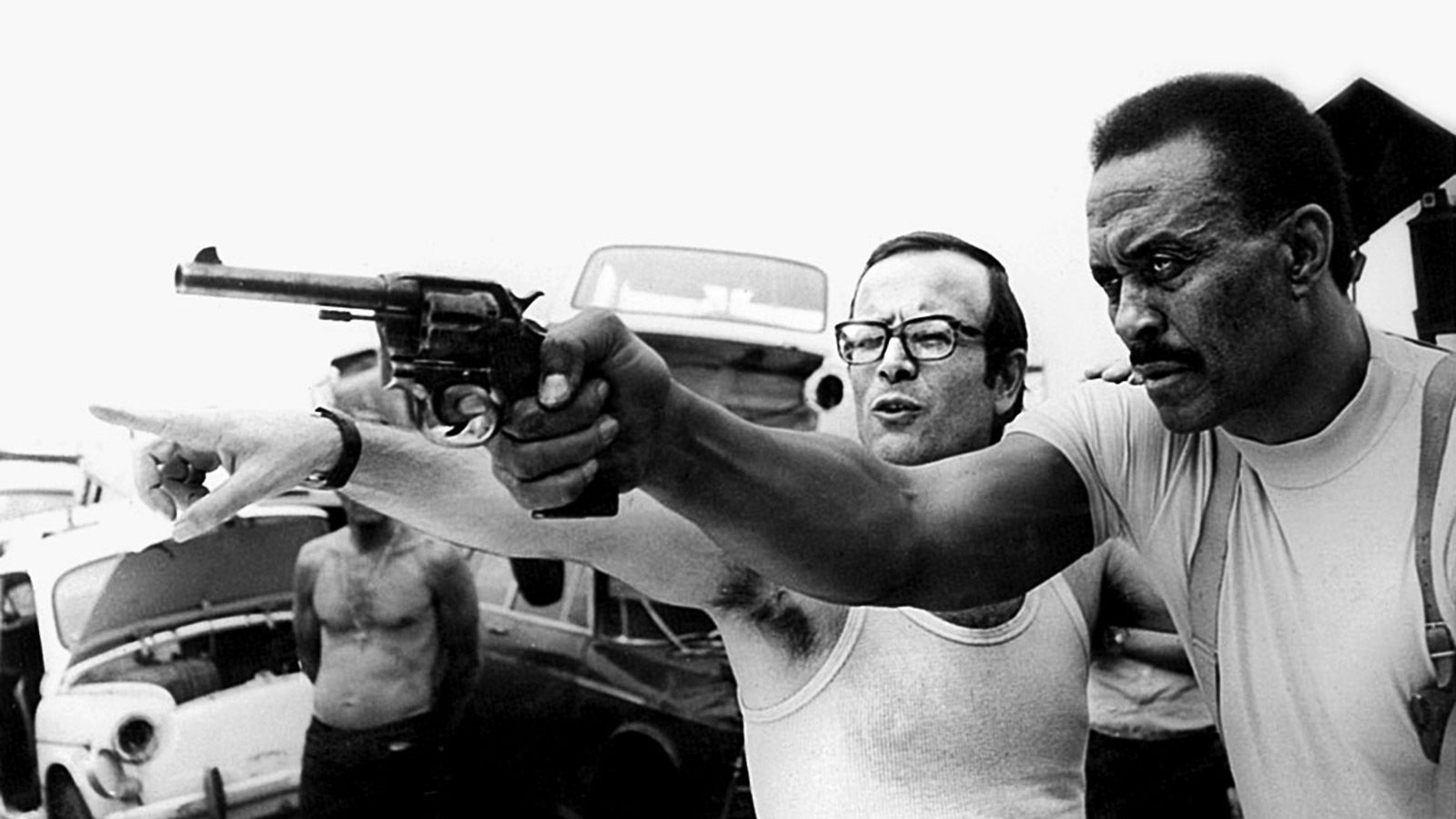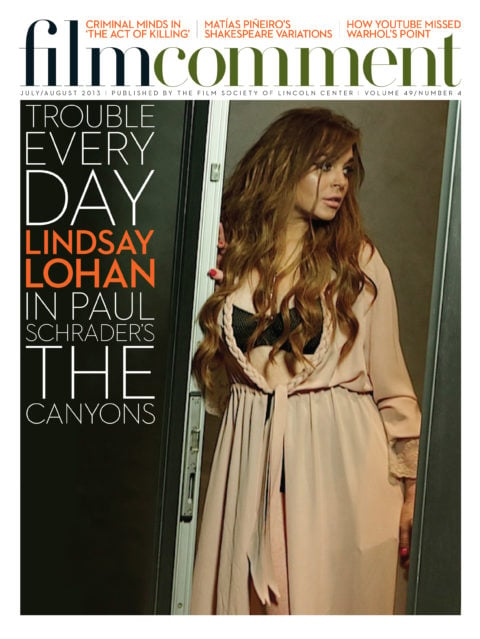By Maitland McDonagh in the July-August 2013 Issue

An Exceptional Vintage
What makes the crime thrillers of Seventies Italian filmmaker Fernando Di Leo superior to standard grind-house fare?
Once upon a time, all that serious film buffs knew about Italian cinema di genere was that it was a vast wasteland of “kiss kiss, bang bang” for undiscriminating viewers who, well into the Seventies, still went to the movies the way Americans used to.

From the July-August 2013 Issue
Also in this issue
Mainstream American reviewers routinely ignored Fernando Di Leo’s crime movies because at the time, advance press screenings for genre movies—whether Hammer horror, spaghetti Westerns, homegrown regional exploitation, or Euro-erotica—were rare, and few critics felt compelled to brave sticky grind-house floors in search of the occasional gem in the maelstrom of junk.
But Di Leo was more than a cog in the machine of Italy’s ruthlessly au courant cinema of international appropriation: he was fiercely committed to making genre movies that addressed contemporary social and political issues. His To Be Twenty (78), about two “young, beautiful and pissed-off” hitchhikers enjoying the dregs of hippie hedonism, is a prescient sucker punch that predates Virginie Despentes’ polemical Baise-Moi by two decades and can still stun jaded moviegoers into appalled silence. Di Leo’s work didn’t go entirely unnoticed: he found admirers among the handful of grind-house regulars who actually went to see movies rather than cruise the men’s room, score drugs, or sweet-talk hookers grabbing a short break from pavement-pounding. One admirer was named Quentin Tarantino, who modeled Pulp Fiction’s three-variations-on-a-theme structure on Di Leo’s “Milieu trilogy.” In Caliber 9 (72), a low-level mob flunkie long-suspected of stealing $300,000 from a Milanese boss is newly sprung from jail and hounded by cops, punks, and the boss’s Javert-like enforcer, whose sputtering declaration of hopelessly compromised principle brings it to a conclusion worthy of Fritz Lang; The Italian Connection (72) features an interracial team of hit men (Henry Silva and Woody Strode); and The Boss (73) is a bleak exercise in life-and-death gamesmanship that starts with a bang—a porno theater full of incinerated mobsters—and ends with a despairing whimper.
The Tarantino stamp of approval aside, Di Leo is exhibit A in the case for European exploitation movies. Which goes something like this: if you skim off the top and bottom 10 percent of U.S. and European exploitation films and consider what’s left, the European movies are, overall, more interesting than their American counterparts. Not because individual Italian or Spanish or German filmmakers were inherently smarter or less crass or better educated than American ones (though to be honest, most of the Europeans are generally better educated and parented), but because by virtue of having been born in Venice or Barcelona or Berlin or Rome, they were immersed from birth in a richer cultural, historical, and political environment.
Born in San Ferdinando di Puglia, the son and grandson of lawyers, Di Leo (1932-2003) discovered noir fiction as a teenager—André Gide’s admiration for Dashiell Hammett led him to the nihilistic Red Harvest. Film noir came later with the American movies that flooded Italy after World War II. Di Leo dutifully studied law, but his heart wasn’t in it. His first movie credit, as writer and director, was a 20-minute segment of a low-budget 1964 portmanteau movie called Heroes of Yesterday, Today and Tomorrow (Gli eroi di ieri, oggi, domani). By his account it was a glorified student movie, but the students were from the Centro Sperimentale di Cinematografia, to which he subsequently applied. He was accepted, then declined to attend and instead gambled that he could find work without a diploma.
And he did, collaborating on screenplays for dozens of spaghetti Westerns, even though he thought the genre “infantile,” except for A Fistful of Dollars (Di Leo was one of that film’s three uncredited writers, as he was on For a Few Dollars More). When offered the opportunity to direct one, he turned it down, holding out for something—anything—else, which turned out to be the Dirty Dozen–inspired Code Name, Red Roses (68), which had the misfortune to open against the Italian release of The Dirty Dozen itself.
Like all Italian commercial filmmakers, Di Leo went where the market took him—war movies, horror, erotica, psychological thrillers—whatever was selling at home and abroad. But he found his calling in the ultraviolent crime movies that flourished in the wake of Dirty Harry and The French Connection. They were dubbed poliziotteschi, a term inflected with a hint of scorn, but Di Leo approached them with a moralist’s sensibility, even when scripting an off-kilter Starsky and Hutch knockoff like Live Like a Cop, Die Like a Man (76), in which a crime-predicting computer (à la Phillip K. Dick’s “The Minority Report”) lets two cohabiting Special Squad hotshots nail miscreants before they break the law. It’s a jaw-dropping evisceration of buddy-cop tropes: the boys would be adorable if they weren’t sociopaths who barely notice the collateral carnage bobbing in their joined-at-the-hip wake.
Di Leo’s films are supremely of the Seventies, from the clothes and accessories—shirts with flared collars, wide sleeves, and tight cuffs; faded bell-bottoms; denim hot pants; Sansabelt slacks; aviator sunglasses; pastel V-neck pullovers; sprayed-to-perfection hair (and that’s just the men)—to the liquor of choice, which is, of course, J&B scotch, official drink of Italian exploitation, its red-and-yellow label radiating cosmopolitan chic from barroom shelves, office sideboards, and bedside tables. But they’re driven by his understanding of the sociopolitical forces that produced gangsters, dirty cops, delinquents, citizen vigilantes, blinkered government officials, sanctimonious clerics, and middle-class puritans, and his contempt for the damage they wrought. The hallmark of Di Leo’s films is a clear-eyed consideration of moral choices and their consequences.
Di Leo worked within genre conventions and cast according to prevailing practice, using a mix of European B-movie stalwarts (Edmond Purdom, Al Cliver, Adolfo Celi, Ray Lovelock), American character actors (Lionel Stander, Henry Silva, Woody Strode, Richard Conte), and fading Hollywood stars like Jack Palance and James Mason, who still had European marquee value. But his films are not period pieces, curios trapped in amber and transformed by time into kitsch. Their sheer ferocity remains undimmed, and 1974’s Shoot First, Die Later (Il poliziotto è marcio, literally “Rotten Cops”) and Kidnap Syndicate (75) are perfect mid-career examples of Di Leo’s ability to take superficially conventional crime stories and invest them with near-operatic emotional impact.
Shoot First, Die Later, based on Rogue Cop, a 1956 novel by William P. McGivern (The Big Heat), is a tragedy disguised as hardboiled neo-noir. A scrupulously honest carabinieri officer discovers that his greatest victory in life’s endless battle against mediocrity is ultimately a hollow one: his son Domenico, a rising star in the Milan police department, is on the take. The story is familiar, but the sheer ruthlessness of its execution is bracing. Once Domenico makes one compromise too many, no one is safe from the fallout, including children and kittens. And the film’s demolition derby–style car chase is mesmerizing—the sight of boxy little compacts careening around dusty back roads and 18th-century streets built for goat carts is simultaneously funny and nerve-shredding.
Released at the height of Italy’s kidnapping epidemic, Kidnap Syndicate is crueler still, a genuine shocker that begins with the abduction of two boys. One is the son of a wealthy businessman and the other a classmate who tries to intervene on his behalf; his father is a widower and former motocross racer whose marginally profitable garage guarantees time with the boy. Suffice to say that Akira Kurosawa’s High and Low has nothing on Kidnap Syndicate’s simmering undercurrent of impotent fury in the face of social injustice. The real crime is less the kidnapping than the official response, which privileges the recovery of a rich man’s child over that of the garage owner’s kid.
One of Di Leo’s earliest films, Naked Violence (aka Naked Massacre, 69), is less nuanced, but a nervy little picture nonetheless, daring to suggest that Italy’s rebellious, alienated youth didn’t just sprout like mushrooms after a summer rain. Adapted, like several of Di Leo’s films, from a novel by popular crime writer Giorgio Scerbanenco, it opens with the rape and murder of a young night-school teacher by her teenage students. The surly, drunken delinquents (they look like hustlers who’ve been ridden hard and put up wet) consistently implicate the class’s designated outsider, a Montenegrin refugee who’s also the only openly gay boy in the vicinity. Naked Violence is hobbled by a credibility-challenged story and a truly terrible score that punctuates every dramatic moment with a portentous crescendo, but it showcases Di Leo’s greatest strength. If this filmmaker’s heart lay with the ignored, exploited, and dispossessed, his passions were tempered by his head, which counseled that fighting violence with more violence was inevitably a zero-sum game.







